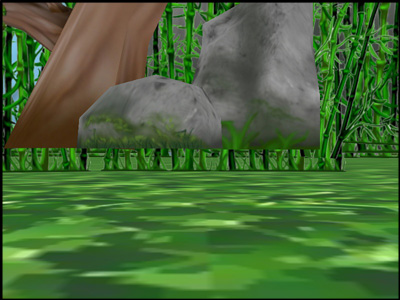With Panda3D running properly, it is now possible to
load some grassy scenery. Update your code as follows:
|
import direct.directbase.DirectStart
#Load the first environment model
environ = loader.loadModel("models/environment")
environ.reparentTo(render)
environ.setScale(0.25,0.25,0.25)
environ.setPos(-8,42,0)
#Run the tutorial
run()
|
The command loader.loadModel()
loads the specified file, in this case the environment.egg file in the
models folder. The return value is a 'NodePath', effectively a
pointer to the model. Note that Panda Filename Syntax uses the
forward-slash, even under Windows.
Panda3D contains a data structure called the scene
graph. The scene graph is a tree containing all objects
that need to be rendered. At the root of the tree is an object named
render. Nothing is rendered until it is first
installed into the scene graph.
To install the grassy scenery model into the scene
graph, we use the method reparentTo. This sets the
parent of the model, thereby giving it a place in the scene graph. Doing
so makes the model visible.
Finally, we adjust the position and scale of the model.
In this particular case, the environment model is a little too large
and somewhat offset for our purposes. The setScale
and setPosition rescale and recenter the model.
Go ahead and run the program. You should see this:

The rock and tree appear to be hovering. The camera
is slightly below ground, and backface culling is making the ground
invisible to us. If we reposition the camera, the terrain will look
better.
|